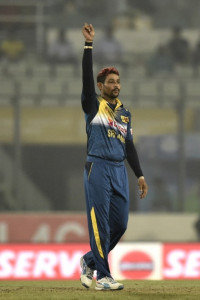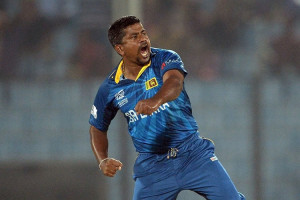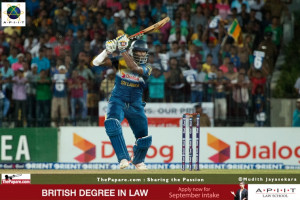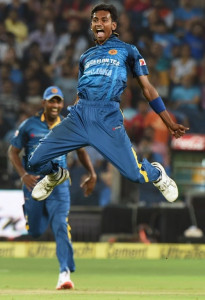Sri Lanka have long had a reputation of producing their best cricket at the biggest of stages and the Asia Cup has told many a Lankan success story in the past.
In fact Sri Lanka is the 2nd most successful team in Asia Cup history, behind arch rivals India, having made it to the finals of 11 of the 13 tournaments thus far, clinching 5 titles along the way. However, at the recently concluded maiden T20 edition of the Asia Cup, the Lankans only managed one win, that too against a team that is yet to register a win in Asia Cup history: UAE. Here’s our take on how the team performed over the two week tournament.
Mathews appointed Sri Lanka T20 captain; Thirimanne & Lakmal included
The Batting woes
“A team in transition” is a the most commonly used term when it comes to describing or rationalizing Sri Lanka’s batting woes. The loss of stalwarts Mahela Jayawardene and Kumar Sangakkara since the last Asia Cup has definitely taken its toll but it has been a year since both Jayawardene and Sangakkara have donned the coloured jersey for the team and the rationale of “a team in transition” is fast becoming a lame excuse for Sri Lanka’s miserly run with the bat.
One of the most concerning factors has been the form of senior batsman TM Dilshan. Dilshan has long been considered as an unseen force behind Sri Lanka’s success in the limited overs formats and so it is quite understandable that his bad run of form in the T20’s have meant that Sri Lanka’s fickle middle order has been left with too much to do. In fact before his 75* in the last game versus Pakistan, he had not surpassed the 30 run mark in his last 7 innings. With the emergence of Kusal Janith Perera over the past couple of years, Dilshan was allowed to play a more sedate role at the top of the order but Perera’s absence due to a ban has left him shouldering more responsibility. His latest opening partner Dinesh Chandimal has provided some relief to the veteran, however the fact that both of them tend to play a similar type of game has left their roles in the side somewhat undefined.
Angelo Mathews is another senior who has been out of sorts in the recent past. Since Sri Lanka’s World T20 triumph in 2014, Mathews has made just one half century (quite understandable considering the fact that he bats down the order) however what is most disconcerting is his strike rate. In the same period of time, his strike rate has topped 100 on only 3 occasions, with his most recent strike rates being 88.88, 60.00 and 94.73 at the Asia cup against UAE, Bangladesh and India respectively. This is completely uncharacteristic of the man who has been anointed Sri Lanka’s “finisher”. Mathews’ form or lack thereof has meant that Sri Lanka has been unable to end innings the way they would want to. During the tournament, Sri Lanka averaged a total of 72.5 runs in the last ten overs over the 4 games. Seems acceptable at first glance but consider the following breakdown of scores that show how Sri Lanka have lost wickets in a heap in the latter part of the innings:
| Opponent | 1st Ten Overs | Last 10 Overs | Total |
| UAE | 72/1 | 57/7 | 129/8 |
| Bangladesh | 66/1 | 58/7 | 124/8 |
| India | 47/3 | 91/6 | 138/9 |
| Pakistan | 66/0 | 84/4 | 150/4 |
Players like Milinda Siriwardene, Thisera Perera, Dasun Shanaka and Chamara Kapugedara have all been given a run at the finishing role in the death overs with little to no success.
Which brings us to the next cause for concern in the Sri Lankan camp: the batting order. Upon the retirements of Jayawardene and Sangakkara, it seemed like Lahiru Thirimanne and Dinesh 
Dwindling Bowling stocks
Over the years, Sri Lanka’s success in major tournaments have, on most occasions, been on the back of solid bowling performances. So it was a cause for much relief when Sri Lanka started the tournament with a bang in the bowling department with Lasith Malinga making a spectacular comeback to competitive cricket, claiming 4 for 26 while Sri Lanka’s tireless and often thankless servants Nuwan Kulasekara and Rangana Herath picked up 5 wickets between them. Things looked good for Sri Lanka until Malinga sustained, what is now being considered, quite a serious injury to his left knee; Sri Lanka were left with only two specialist fast bowlers in Kulasekara and Dushmantha Chameera in the squad. This meant that Mathews was forced to use Chameera in the middle-latter overs, instead of the early overs where he may have had more of an impact.
The wisdom of opting for 3 specialist spinners in Rangana Herath, Sachithra Senanayake and Jeffrey Vandersay is quite debatable as it is unlikely that Sri Lanka will field more than one 
Perhaps an option Sri Lanka could have considered was going with Kasun Rajitha, who had a standout game against India in Pune not too long ago, instead of Jeffrey Vandersay, who has not played a game since his appearance in New Zealand in early January (where he went for 40 odd off two overs).
Unfulfilled Potential

Thisera Perera has perhaps been the most disappointing of them all as he is someone who even the fans identify as someone with tremendous potential. It is fair to say that neither his bowling nor his batting has progressed much in the last couple of years, in fact, statistics would suggest he has gotten worse. In the three games at the Asia cup, he bowled 7.2 over, conceding 71 runs for just the solitary wicket. He only batted twice in the tournament and was, to be fair, hard done by poor umpiring just when he was hitting his straps against India.
Not all doom and gloom
One of the major positives Sri Lanka will take out of the Asia Cup is the batting of Dinesh Chandimal, who produced a string of good performances in an unfamiliar position at the top of the order. He was the top run getter for the Lankans, making 149 runs at an average of 37.25 and provided some stability to the Sri Lankan batting throughout the tournament.

Sri Lanka’s latest prodigy Dushmantha Chameera has been a revelation since his debut and he was good with the ball here too, filling in at the death in the absence of Malinga. He went for 111 runs, at 7.23 runs an over, while picking up 3 wickets.
Perhaps Sri Lanka’s biggest sigh of relief came in the last game, against Pakistan, where TM Dilshan signalled his comeback to form with a knock of 75 off 56 deliveries. He also picked up a crucial wicket in the solitary over he bowled and has indicated that he would like a bigger role in the bowling department as well.
Final Say
The problem seems to be the lack of a proper definition of roles for the players, in particular the batsmen with the constant shuffling of the batting order perhaps a contributing factor. Sri Lanka could get away with scores of 120-140 in the past purely because our bowling line-up was rock solid but now, particularly in batsman friendly conditions, the chinks in the batting are definitely beginning to show.



















